Hockey drills
- A 3 v 2 with running lines set out, expanded to a 4 v 3.
- Red plays on white and then taps the other red pilon before getting into the ball and passing it wide to blue.
- Blue returns the ball to white who has run on and the three players play a 3 v 2 on orange.
- Can be extended to a 4 v 3 with an extra defender and attacker in the circle.

- Bigger finishing exercise with lots of meters.
- Turn over
- 1-2-3-4-1
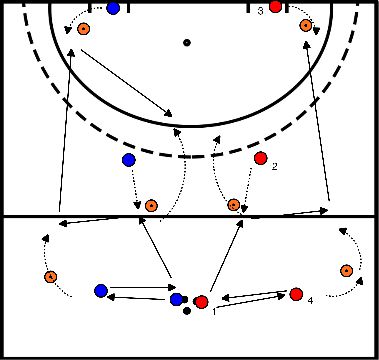
- On a quarter of a field, set out several exercises,
- The players can start directly after each other.
- From slalom,
- dummy,
- herring trick
- to a walk you can set out.
- So that during the warming up they can focus on all the techniques.
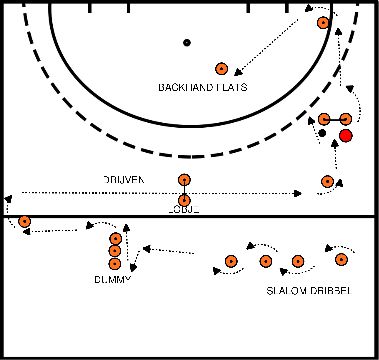
- 3 teams
- 2 goals on more than quarter field
- Team 1 and 2 start in the field, team 3 over the back line outside the field. Team 1 starts with goalie
- As soon as one of the teams scores, this team stays, the other team goes out and is replaced by the team on the side
- There is always a turn so that the strong team stands by the goalkeeper.
- Team 1 scores? Team 1 stays with the goalie, team 2 goes out and 3 comes in on the other side
- Team 2 scores? Team 1 out, Team 2 by the goalie and 3 in on the other side
- Teams always go in on the same side
- Alternate with shuttles in between
- 4v3 situation where trainer indicates to whom the ball should be played (left, right or centre) over two sides.
Situation on the left:
- Player plays into a teammate (red dots)
- Trainer calls left, right or central (variant white, red, blue)
- Depending on the trainer's instructions, L, R or C is played in;
- After this there is a 4:3 (white attacks and rose defends).
- After playing the ball red is allowed to defend immediately.
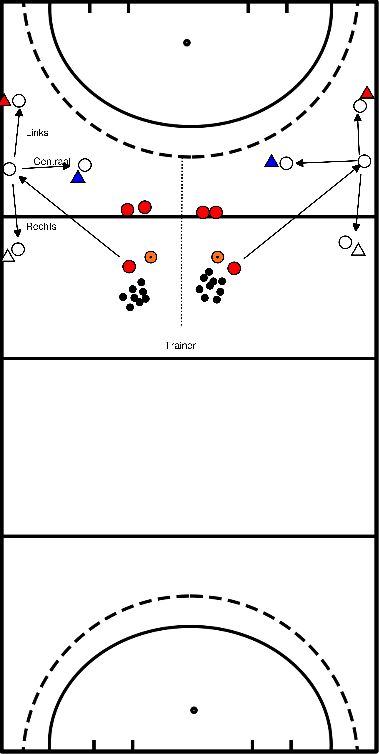
1 v 1
- Make a square from 5m-5m and play a 1v1. the defender is only allowed to defend with his body so no stick.
- Focus on defence.
- Use your body to force them to go to your strong side.
- When you push them to the side make a block tackle.
- Block tackle is always on the forehand, 2 hands on the stick and step forward.
- Stick is on the ground.
- Jab:
- Make a small square 1m-1m.
- The defender is inside the square and the attacker tries to get the ball inside the square.
- The defender use the jab to defend his square.
- You jab with your stick to the ball.
- Left foot in front and right food in the back (not flat fooded).
- Use your stick as poke.
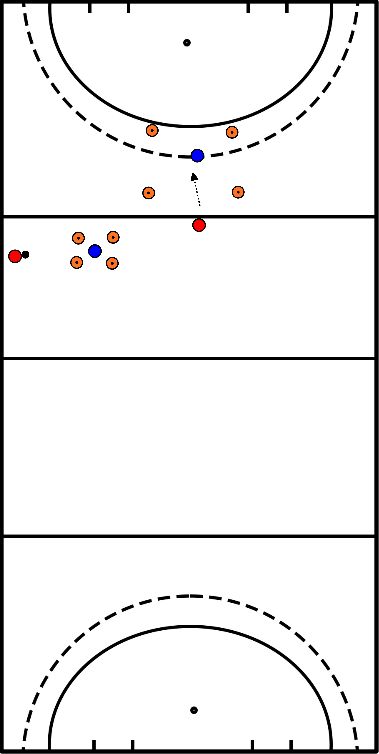
- Flats,
- Open take,
- Accelerate & push pass from the run (if necessary, alternate the exercise with other techniques such as hit, push pass, backhand pass)
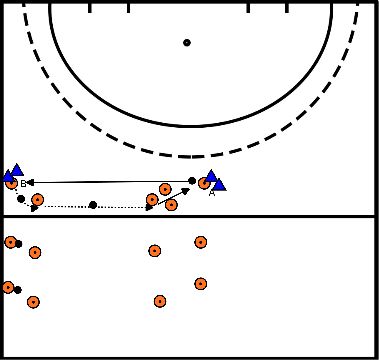
- This step is performed in different ways.
- The easiest way is to make a kind of sideways jump.
- It is also possible to make a cross pass, which brings you to the same height as the jump.
- Make sure that your left foot reaches the same height as the ball during your run-up
- You should place your foot about 30 cm away from the ball, so that you have enough space to place your stick near the ball
- At a high level, the drag flick is a common variant of the penalty corner.
- It is also the only variant where the ball can be played at high speed, high on the goal.
- Below, the basic technique of the sledge push is explained in 4 steps.
- The backhand stroke is useful for a shot on goal but also to pass to your teammate.
- With the backhand, you place your left hand at the end of your stick and your right hand slightly above the middle of your grip.
- Usually you play a backhand from the barrel.
- When your right foot is in front you let the ball roll a little bit.
- Meanwhile you turn your stick to the backhand, you bend your right knee and then you hit the ball with the part of your stick just above the curl (make sure the ball doesn't stick in the curl otherwise you have no control over it).
- You can make the ball go low or high by turning your stick.
- With a diagonal stick the ball flies upwards, with a straight stick it stays on the ground.
- Sit-ups Make 2 pairs so that the players can take turns holding each other's feet.
- Each player does these sit-ups: 10 times, 15 times, 20 times during which they rest by helping the other.








